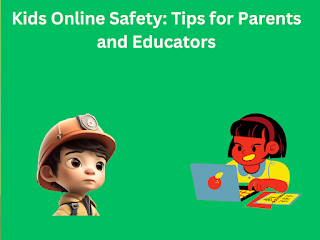Kids Online Safety: Tips for Parents and Educators
In Today's digital era, children are exposed to the online world more than ever before. While the Internet offers numerous educational opportunities and entertainment, it also comes with potential risks. As parents and educators, ensuring kids online safety is of paramount importance. This comprehensive guide will provide valuable tips and insights to safeguard children from various online threats, including cyberbullying, inappropriate content, and online predators. Let's explore practical strategies to protect the younger generation in the vast digital landscape.
Understanding the Risks
Before we delve into the tips for online safety, let's understand the risks children may encounter in the online realm. It's essential to be aware of these threats to effectively mitigate them.
Cyberbullying and Online Harassment
Children can be targets of cyberbullying, where individuals use electronic communication to harass, intimidate, or humiliate them. This can lead to emotional distress and negatively impact their mental health.
Inappropriate Content Exposure
The internet houses an abundance of content, not all suitable for children. Inappropriate material, such as violence, explicit imagery, or harmful ideologies, can be accessed accidentally or intentionally.
Online Predators
Some individuals with malicious intent may pose as friends or peers to gain children's trust and exploit them for their personal gain. This could lead to dangerous situations or privacy breaches.
Phishing and Scams
Children might be vulnerable to falling for phishing scams or sharing personal information with malicious actors, leading to identity theft or other fraudulent activities.
Tips for Parents and Educators
To ensure children's online safety, parents and educators can implement the following strategies:
1. Establish Open Communication
Encourage open and honest communication with children about their online experiences. Create a safe space where they feel comfortable discussing any concerns or encounters they face while using the internet.
2. Set Clear Online Rules and Boundaries
Define rules regarding internet usage, screen time, and appropriate websites or apps. Establish age-appropriate restrictions and guidelines for accessing content and social media platforms.
3. Educate Children about Online Safety
Teach children about the potential risks they may encounter online, such as cyberbullying, sharing personal information, or interacting with strangers. Educate them on safe practices and responsible internet behavior.
4. Use Parental Control Software
Employ parental control tools to monitor and manage children's online activities. These tools can help block inappropriate content and restrict access to certain websites or applications.
5. Keep Devices in Shared Spaces
Encourage the use of digital devices in common areas of the house or classroom. Supervising online activities becomes more manageable when screens are visible to adults.
6. Foster Critical Thinking
Teach children to think critically and question the reliability of online information. Instill the habit of fact-checking and identifying fake news or misleading content.
7. Encourage Strong Password Practices
Instruct children to use strong and unique passwords for their online accounts. Explain the importance of password security to prevent unauthorized access.
8. Monitor Social Media Activity
Keep an eye on children's social media interactions and friend lists. Be aware of any signs of cyberbullying or suspicious behavior.
9. Be a Good Digital Role Model
Lead by example and demonstrate responsible online behavior. Children often mimic the actions of adults, so exhibiting safe internet practices sets a positive precedent.
10. Teach Privacy Settings
Show children how to adjust privacy settings on their social media and online accounts to limit the visibility of personal information.
11. Discuss Cyberbullying and Its Consequences
Explain the harmful effects of cyberbullying on both the victim and the perpetrator. Encourage empathy and kindness in online interactions.
12. Limit Location Sharing
Advise children not to share their exact location or travel plans publicly. Location data can be misused by strangers or cybercriminals.
13. Use Secure Wi-Fi Networks
Educate children about the importance of connecting to secure and trusted Wi-Fi networks. Public or unsecured Wi-Fi can pose security risks.
14. Enable Two-Factor Authentication
For older children with online accounts, enable two-factor authentication for an extra layer of security.
15. Monitor App Downloads
Supervise app downloads and ensure that children are only installing reputable and age-appropriate applications.
16. Teach Safe Online Shopping
If children engage in online shopping, teach them to use secure payment methods and only shop from trusted websites.
17. Recognize Online Red Flags
Teach children to recognize red flags in online interactions, such as pressure to share personal information or meet in person.
18. Encourage Reporting
Emphasize the importance of reporting any suspicious or uncomfortable online encounters to a trusted adult.
19. Address the Consequences of Actions
Explain to children the potential consequences of their online actions, both positive and negative.
20. Stay Updated on Online Trends
As a parent or educator, stay informed about the latest online trends and platforms to better understand the digital landscape children are navigating.
21. Promote Offline Activities
Encourage children to engage in offline activities, such as sports, hobbies, or reading, to balance their screen time.
22. Foster a Supportive Environment
Create a supportive environment where children feel comfortable seeking help if they face any online challenges.
23. Collaborate with Schools and Other Parents
Work together with schools and other parents to reinforce online safety practices and share insights and experiences.
24. Be Aware of Gaming Risks
If children play online games, be aware of potential risks, such as exposure to inappropriate content or interaction with strangers.
25. Stay Informed about Online Safety Tools
Keep yourself updated about new online safety tools and resources that can further enhance children's protection.
FAQs
Can I completely shield my child from online risks?
While it's challenging to eliminate all online risks, you can significantly reduce them by implementing safety measures, open communication, and monitoring your child's online activities.
How can I talk to my child about cyberbullying?
Initiate an open conversation with your child about cyberbullying, its impact, and how they can seek help if they encounter such behavior.
Is parental control software effective?
Parental control software can be a useful tool to manage and filter content, but it's crucial to complement it with digital education and communication.
At what age should I allow my child to have a social media account?
The appropriate age for social media depends on your child's maturity level and the platform's age requirements. Many social media platforms have a minimum age of 13.
What should I do if my child encounters inappropriate content online?
Explain to your child the importance of immediately closing the browser or app and seeking your guidance if they accidentally come across inappropriate content.
How can I report online predators or suspicious activities?
Most online platforms have reporting mechanisms for inappropriate behavior or content.
Visit my Youtube Channel: Digital Education for Kids



Comments
Post a Comment